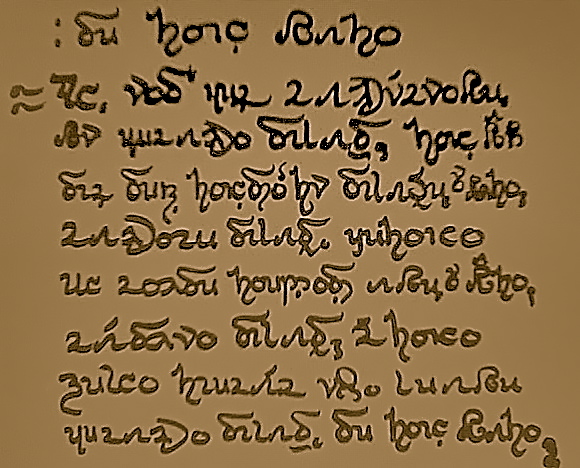The LCC3 Relay
Welcome to the LCC Relay! Use the navigation ring below to choose a destination:
Introduction | Rules | Participants | Summary | FAQ
Previous LCC Relays | All Previous Relays
2. Silindion by Elliott Lash
Texts | Syntax | Lexicon | Suffixes | Poetic Form | Extra Info | Image
Previous (David Peterson, Kamakawi) | Next (Jan van Steenbergen, Wenedyk)
|
Silindion Ud, ëas' ini noskénëavi, Vë inoska sulos. Manda voma. Sunu sinti mandasya 'më sulophi, noskani sulos, imanda voma. Id naksi maissiasya ovi, nóskëa sulos. Në manda voma. Tilda muinón ehya liovi Inoska sulos, si manda voma. Hear it! |
Smooth English 'Behold there, I am beside the shore, while the ocean crashes. It drifts away. I want to drift away on the ocean the crashing ocean, drifting away. There are all my dreams, upon it that the ocean is crushing. And it drifts away. Seeing the ship of my wife, the ocean crashing, I drift away.' |
Syntax
Website: http://wiki.frath.net/Grammar_of_Silindion
- When a subject pronoun is used, it is placed before the verb, which is in the 3rd person (regardless of the person of the subject). This is because this is really a reduced cleft stentence: si tilíno 'it's me who sees him.' = 'I see him'.
- The locative can express alienable possession (i.e. possession in which the possessum is not necessarily possessed, only incidentally possessed. That is, the difference between 'my arm' and 'my book').
- The adjectival gerund can be used with arguments to form a reduced relative clause. This distinguishes it from the present participle which cannot take arguments. Thus, one might say that (roughly) the adjectival gerund is more transitive than the present participle.
- Modifiers generally precede the noun (at least in this poem, but this is a poetic- style).
- The conjunctive gerund indicates circumstantial meanings (since, because) or simultaneous meanings (while).
- The i- in the conjunctive gerund can be stylistically dropped.
- The subject of the nominal gerund is either genitive (if nominal) or a possessive suffix (if pronominal).
Lexicon
- ë-
- be (ay-stem, V)
- ehya
- my, mine
- emë
- on (+loc)
- id
- see, behold, there are, there is (proximal)
- ini
- beside (+loc)
- lio
- wife (o-stem, N)
- maD-
- bring, take (D-stem, V); (3rd sg. present: manda)
- maD-
- voma 'drift away'
- maissë
- dream (ay-stem, N)
- muino
- ship, boat (o-stem, N)
- naksi
- all
- në
- and
- nosk-
- crash (intr.) (said of waves hitting the shore); crush (tr.) (sk-stem, V)
- noskenë
- edge of the sea, shore, marge (ay-stem, N)
- o-
- it (oblique stem)
- si
- I
- siT-
- me (oblique stem)
- su-
- want (u-stem, V) (always passive)
- sulos
- wave, ocean (s-stem, N)
- til-
- see (l-stem, V)
- ud
- behold, there is, there are, see (distal)
- vë
- as, while
- voma
- back, away
Suffixes
- -a-
- thematic vowel
- -si
- 1st singular
- -vi
- locative case (-phi, in s-stems)
- (i-)...-[n/d]a
- conjunctive gerund
- -na
- nominal gerund
- -sya/-hya
- 1st singular possessive suffix (-hya after vowels)
- -ani
- present participle (cannot take arguments)
- -[n]ëa
- adjectival gerund
- -n
- accusative (disappears before -s-)
- -ni
- pronominal dative (after oblique stems, metathesis with consonants)
- -nV
- passive/impersonal 3rd singular (V = vowel of root, repeated)
Poetic Form
First line of each stanza ends in -vi (-phi)
Second line has ten syllables and ends in -ma
Also: vocabulary is rather poetic (sulos for sulindo, noskenë for kenë)
Extra Info
The poem is divided into two halves by the particles: id/ud. In the first, introduced by 'ud', the narrator is removed from the event, setting it up and finally, in the third line stating his feelings/thoughts about the event. In the second half, introduced by 'id', we are brought fully into the mind of the narrator so that we can feel his pain as we realize the poem is a lament for his departed wife. This thus illustrates one of the main usages of 'id' and 'ud' as emotional 'proximal' and 'distal' markers.
Also, you may want to note that there are four different ways of writing the word 'voma' in the manuscript.
In the first line (or title, the part after :) it is written in full at the end of the line. The title reads ' : Si manda voma '
At the end of the third line, it is written v - o (superscript) - small-m - a (superscript)
At the end of the fourth line, it is written v - attenuated-o - m - a (also, the symbol before this which looks like an < o > with little horns, means that the word following actually goes at the end of the following line, when reciting it. It's a space saver)
At the end of the sixth line, the word is written v - o (superscript) - m - a (again following the horned-o symbol)
This is a small introduction to the various ways of writing in Silindion manuscripts.
Image

Top
Previous (David Peterson, Kamakawi) | Next (Jan van Steenbergen, Wenedyk)
